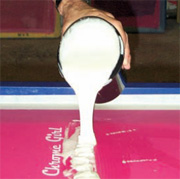White plastisol is white plastisol, right? On the surface it all seems simple, but there are a variety of whites on the market and a variety of uses.
Here’s a breakdown to help you and your staff understand your white plastisol ink options.
All Purpose White
All purpose white, sometimes referred to as transparent white, was created for use on light colored garments. Some ink producers offer more than one all purpose white under different ink series, while others may offer only one. The underlying use and purpose for this ink is as a highlight white, whether with true process prints, simulated process, or with spot color designs. This ink is not commonly found on most production floors. Most screen printers prefer to limit, wherever possible, the numbers of inks in their inventory. Instead, these printers will opt to use an opaque white on both light and dark garments. Thinning this opaque white curable reducer makes it effective as a highlight ink.
If you do substantial printing with white ink on light garments, all purpose white may be your best choice. It is less expensive than an opaque white due to its lower solids content. Other benefits include: a shorter flash time, ease of printing, and a softer hand on the finished garment.
Opaque White
Opaque white is specifically formulated to offer a crisp, clean, white print on dark 100% cotton garments. Note that we are talking about 100% cotton garments only. This white ink is produced without the required chemistry to resist bleeding of fabric dye into the ink. Bleeding, or more commonly called dye migration, is a function of cotton/poly blends and should not be an issue with 100% cotton.
Because of the 100% cotton limitation, you might wonder why you would bother with using opaque white. The technical answer involves the ink’s rheology. Opaque white inks will commonly have much better flow properties – ease of printability. White plastisols that are opaque and resist dye migration must include additional chemistry that impacts ease of printability.
If you print only 100% cotton garments, opaque white ink will be more user friendly than a low bleed white. Since standard opaque white plastisol does not require dye blocking chemistry, this ink should be less expensive from your supplier. And, standard opaque white ink will flash cure more quickly and provide a softer hand.
Low Bleed White
Low bleed white is the epicenter of the confusion with white ink options. Low bleeds are also at the root of the confusing assortments of white inks on a supplier’s price sheet. This white ink is formulated to be printed onto dark cotton/poly blends. First, this ink must be opaque enough to mask the garment color. Second, the ink must have the chemical makeup to resist dye migration from the polyester part of the fabric blend. Important note, these inks are NOT called No Bleed. These inks are called Low Bleed. There is no such thing as a No Bleed ink.
To use these inks to their utmost, be sure your dryer temperature is not too hot, reaching curing temperature at belt level, but not substantially higher as you will find in most shops. We will discuss dryer temperatures and testing methods in future articles.
The principle behind a low bleed ink is simple. First, we need a high pigment level for opacity, and second, we need dye blocking chemistry to resist migration. One customer may want a product that is low bleed, prints well, and flashes quickly. The next customer may determine that the first formulation is too thick and difficult, requesting another more press friendly white ink option. To satisfy customer requests, ink companies offer a variety of formulations.
Different garment dye types are used in the garment manufacturing process. This variety of dyes requires ink manufacturers to develop a variety of dye blocking agents to resist migration. As a result, the ideal low bleed white in one shop might be the least favorite in another, based entirely on the type of cotton/poly garments each of the shops use. Testing is required.
Low Fusion White
Low fusion whites can be flash cured at a lower temperature to prevent damage to temperature sensitive fabrics. If you printed on specialty fabrics, this ink might be your solution.
Fast Fusion White
Fast fusion whites have been created to increase production rates on automatic presses. These inks have been developed for use specifically as an underbase and gel more quickly than standard white inks. An added benefit is a low tack surface after flashing for laying down additional colors.
Some industry experts argue that flashing speed is simply a mechanical issue. To cut flash time, these experts recommend printing through a finer mesh for a faster curing, thinner ink film. Other ink experts argue in return that fast flashing can be accomplished through a chemical process, and that ink film thickness will be virtually irrelevant.













